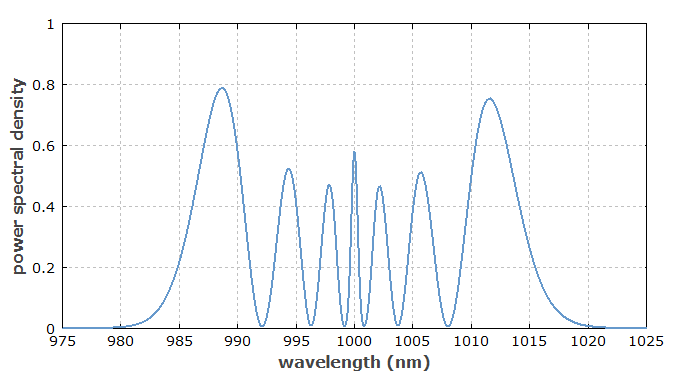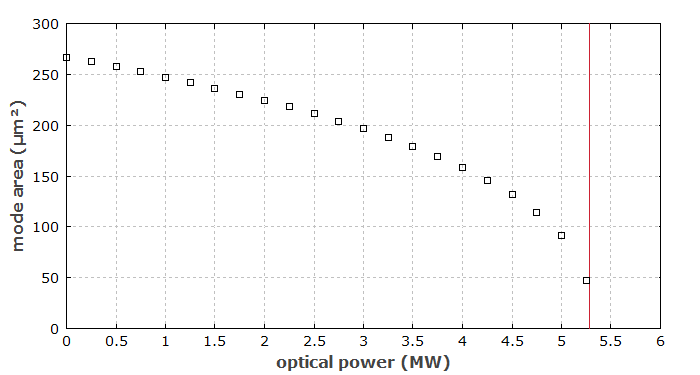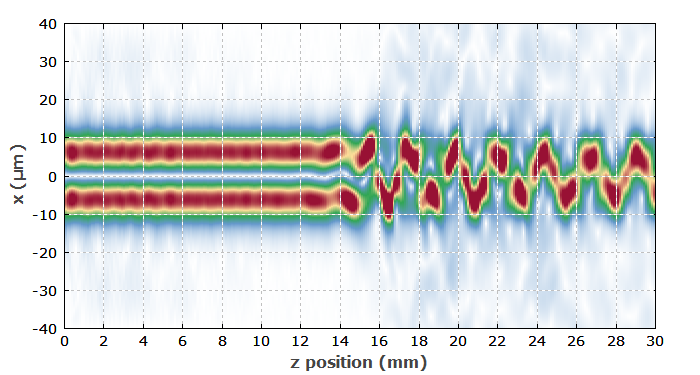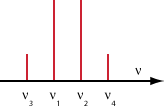Passive Fiber Optics
This is part 11 of a tutorial on passive fiber optics from Dr. Paschotta. The tutorial has the following parts:
1: Guiding light in a glass fiber, 2: Fiber modes, 3: Single-mode fibers, 4: Multimode fibers, 5: Fiber ends, 6: Fiber joints, 7: Propagation losses, 8: Fiber couplers and splitters, 9: Polarization issues, 10: Chromatic dispersion of fibers, 11: Nonlinearities of fibers, 12: Ultrashort pulses and signals in fibers, 13: Accessories and tools
Part 11: Nonlinearities of Fibers
In an optical fiber, light is confined to a small transverse region, so that even moderate optical powers leads to high optical intensities. In addition, light often propagates over considerable distances in a fiber. For these reasons, nonlinear effects due to fiber nonlinearities often have substantial effects. This is particularly the case if fibers are used to transmit short pulses, and in fiber amplifiers for short pulses.
The Kerr Nonlinearity
The simplest and most common nonlinear effect in fibers is the Kerr effect. Essentially, this means that the phase delay in the fiber gets larger if the optical intensity increases. This can be described via an increase of refractive index in proportion to the intensity:
That increase can often be considered as instantaneous, even though this is not exactly true in reality. Below we also consider effects of non-instantaneous nonlinearities.
The nonlinear index n2 is rather small for silica fibers – around 2.7 · 10−16 cm2/W for wavelengths around 1.5 μm. In numerical simulations, one usually uses a value according to the center optical frequency, i.e., tentatively higher values for shorter wavelengths. Other glasses, e.g. fluoride glasses or chalcogenide glasses, often have substantially stronger nonlinearities.
Note that electrostriction leads to some reduction in fiber diameter at high intensities. That effect, however, requires some time. For nanosecond pulses, it leads to some increase of the effective nonlinear index, which is not seen for picosecond or femtosecond pulses. This is one of the reasons why somewhat different nonlinear index values appear in the literature.
Self-phase Modulation
One of the consequences of the Kerr effect is self-phase modulation (SPM). This means that a light wave in the fiber experiences a nonlinear phase delay which results from its own intensity.
For a fiber mode, the phase change per unit optical power and unit length is described by the proportionality constant
(in units of rad/(W · m)) where Aeff is the effective mode area. Interestingly, for a nearly Gaussian mode shape with beam radius w this value is only half the value for a Gaussian beam in a homogeneous medium, where only the on-axis value is considered. In the fiber, we have lower phase changes away from the fiber axis, and the overall nonlinear phase delay is only half the peak value. (Note that the wavefronts of a mode in the fiber are kept approximately plane despite SPM; the mode is “kept together” by the balance of diffraction and waveguiding, and the nonlinear phase change is “spread” over the whole beam profile.)
If an optical pulse is transmitted through a fiber, the Kerr effect causes a time-dependent phase shift according to the time-dependent pulse intensity. In this way, an initial unchirped optical pulse acquires a so-called chirp, i.e., a temporally varying instantaneous frequency. This is shown in Figure 1:

For ultrashort pulses with picosecond or femtosecond pulse duration and a high peak power, the instantaneous frequency can wiggle around in a range of many terahertz. This can lead to substantial spectral broadening, i.e., increase of the spectral bandwidth. Note, however, that the optical spectrum (Fourier spectrum) does not simply reflect the range of instantaneous frequencies. Typically, it shows strong oscillations if SPM is the dominant effect and chromatic dispersion effects (see part 10) are much weaker. This is shown in Figure 2 for an example case:

As explained in our encyclopedia article on self-phase modulation, these oscillations can be understood as a kind of interference effect, related to the fact that the instantaneous frequency reaches each value at two different times.
As a rule of thumb, substantial broadening begins if the nonlinear phase shift exceeds 2π. For a standard single-mode fiber with a mode area of 75 μm2, for example, this starts for a peak power of a few kilowatts over a meter of fiber. Note that 1 kW peak power for a 1-ps pulse means only about 1 nJ of pulse energy; one easily reaches many kilowatts with ultrashort pulses.
Note that chromatic dispersion (see part 10) also often has a strong influence on ultrashort pulses. The overall effect of Kerr nonlinearity and dispersion is therefore strongly dependent on the dispersion properties. For example, soliton pulses can be formed in a fiber with anomalous dispersion. For a fundamental soliton, self-phase modulation and dispersion act together such that there is no temporal or spectral broadening any more. For higher-order solitons, there is a periodic evolution, which becomes rather complicated for high orders. In the normal dispersion regime, chromatic dispersion leads to temporal broadening, which reduces nonlinear phase shifts, and strongly chirped pulses may arise.
Nonlinear Self-focusing
Another consequence of the Kerr effect is nonlinear self-focusing. One can recalculate the fiber modes (see part 2) such that the nonlinear self-focusing is included. The modes then shrink significantly if the optical power reaches 1 MW or higher. This is illustrated in Figure 3:

For a peak power of the order of 5 MW (in silica fibers), catastrophic self-focusing occurs: the shrinking intensity profile further increases the nonlinear focusing effect, which in turn leads to more shrinking, and the profile collapses totally. The enormously high intensities subsequently destroy the fiber; a single ultrashort pulse is sufficient for that.
Self-focusing also destabilizes higher-order modes of a multimode fiber. Figure 5 shows an example, where a power of 4 MW has been injected into the LP11 mode of a fiber (as calculated without the fiber nonlinearity). After about 10 mm of propagation distance, the light is transferred into a mixture of LP01 and LP11:

(This is part of a case study on nonlinear self-focusing.)
Most nonlinear effects can be reduced by using a fiber with a large effective mode area, as this leads to lower optical intensities for a given power level. However, the power threshold for critical self-focusing does not depend on the mode area. This is essentially because larger modes are more sensitive to lensing effects. As a result, the optical peak power in a fiber must always be limited to a few megawatt; self-focusing introduces a rather hard limit.
Cross-phase Modulation
If two different waves, e.g. at two different wavelengths, propagate together in a fiber, there can be a nonlinear phase change of each beam resulting from the intensity of the other beam. This phenomenon of cross-phase modulation (XPM), which occurs in addition to self-phase modulation, can be relevant in optical fiber communications with wavelength division multiplexing, for example.
Curiously, the resulting phase changes are two times larger than one would expect from the equation for self-phase modulation as given above, if both beams have the same linear polarization. For XPM, we then have a phase change of beam 2 resulting from the intensity of beam 1 according to
while a 3 times smaller nonlinear phase change than that would result for orthogonal polarization directions.
Four-wave Mixing

Another effect resulting from the Kerr effect is four-wave mixing. For example, if two wavelength components travel together through a fiber, four-wave mixing may lead to two new frequency components (see Figure 5). This can be understood as follows: the two input frequencies lead to a beat note, i.e., an oscillation of the total intensity with a frequency which is the difference of the two optical frequencies. Through the Kerr effect, this leads to a phase modulation, which creates sidebands. Note, however, that this process can be effective over long lengths of fiber only if it is phase-matched. Otherwise, the amplitudes added to the sidebands at some point in the fiber do not constructively add to those generated at other points. Therefore, four-wave mixing often occurs only near the zero dispersion wavelength of a fiber. Note that the phase matching is also influenced by the Kerr effect.
Parametric Amplification and Oscillation
An effect related to four-wave mixing is optical parametric amplification and oscillation. Injection of light at some wavelength into a fiber can generate a nonlinear gain at other wavelength. That can be exploited for amplifying signals or for parametric oscillation, i.e., the generation of new wavelength components without injecting light at such wavelengths. In contrast to parametric amplifiers and oscillators based on nonlinear crystal materials, parametric fiber devices have signal and idler wavelengths around the pump wavelength, instead of twice the pump wavelength. This is because they are based on a χ(3) nonlinearity rather than a χ(2) nonlinearity.
Non-instantaneous Nonlinear Response
We have already mentioned electrostriction as a nonlinear effect with a finite response time. For quickly changing optical powers, this can excite lattice vibrations. These in turn can influence the propagating light. This leads to stimulated Raman scattering and Brillouin scattering, which are discussed in the following.
Brillouin Scattering
Simulated Brillouin scattering (SBS) is associated with acoustical phonons (in the gigahertz range). It turns out that this interaction can normally be intrinsically phase-matched only such that it couples two counterpropagating optical waves. Energy conservation demands that the optical frequencies differ by the acoustic frequency. If we inject a single monochromatic wave into the fiber, there will be a nonlinear gain for counterpropagating waves with optical frequencies which are lower by the Brillouin frequency shift
which depends on the refractive index, the acoustic velocity and the vacuum wavelength. For silica fibers, the Brillouin frequency shift is of the order of 10–20 GHz, and the Brillouin gain occurs within a bandwidth of typically 50–100 MHz. The Brillouin gain spectrum may actually be substantially broadened by transverse variations of the acoustic phase velocity or longitudinal temperature variations, for example. Accordingly, the peak gain may be reduced.
One might think that one doesn't have to worry about Brillouin scattering if one doesn't inject any counterpropagating light into a fiber. However, if the Brillouin gets quite large – to the order of 90 dB –, it is enough to amplify vacuum noise (the vacuum fluctuations of the electromagnetic field) to substantial power levels. Therefore, above a certain SBS power threshold one suddenly obtains a strong nonlinear reflection of light in the fiber, and low-loss transmission is no longer possible. Unfortunately, that often nasty effect can kick in at rather low power levels, at least for light with a low optical bandwidth. For example, for a fiber length of 10 m it may occur for only a few watts of optical power.
A common method to suppress SBS is to make sure that injected light has a large optical bandwidth. This “smears out” the Brillouin gain spectrum and accordingly reduces the peak gain. For ultrashort pulses, SBS then basically disappears as a problem – but Raman scattering can still occur:
Raman Scattering
Stimulated Raman scattering (SRS) is based on optical phonons, having quite high frequencies in the terahertz range. Here, the interaction is similarly strong in forward and backward direction. Backward scattering can be suppressed for short pulses, as these can overlap in a fiber only over a limited length. Forward SRS, however, can act over a long length of fiber and can lead to a substantial transfer of power to a Raman-shifted wavelength component, which typically has a wavelength which is longer by some dozens of nanometers. That effect is already substantial for a nonlinear Raman gain of 40 dB: one requires less nonlinear gain than for Brillouin scattering, as it occurs in a much broader bandwidth (several terahertz).
If a pulse has a very large optical bandwidth, SRS may even act within the pulse spectrum: energy is redistributed from higher-frequency components to lower-frequency components of the pulse. As a result, the overall pulse spectrum drifts towards longer wavelengths.
Go to Part 12: Ultrashort Pulses and Signals in Fibers or back to the start page.
Questions and Comments from Users
Here you can submit questions and comments. As far as they get accepted by the author, they will appear above this paragraph together with the author’s answer. The author will decide on acceptance based on certain criteria. Essentially, the issue must be of sufficiently broad interest.
Please do not enter personal data here; we would otherwise delete it soon. (See also our privacy declaration.) If you wish to receive personal feedback or consultancy from the author, please contact him e.g. via e-mail.
By submitting the information, you give your consent to the potential publication of your inputs on our website according to our rules. (If you later retract your consent, we will delete those inputs.) As your inputs are first reviewed by the author, they may be published with some delay.



These sharing buttons are implemented in a privacy-friendly way!



